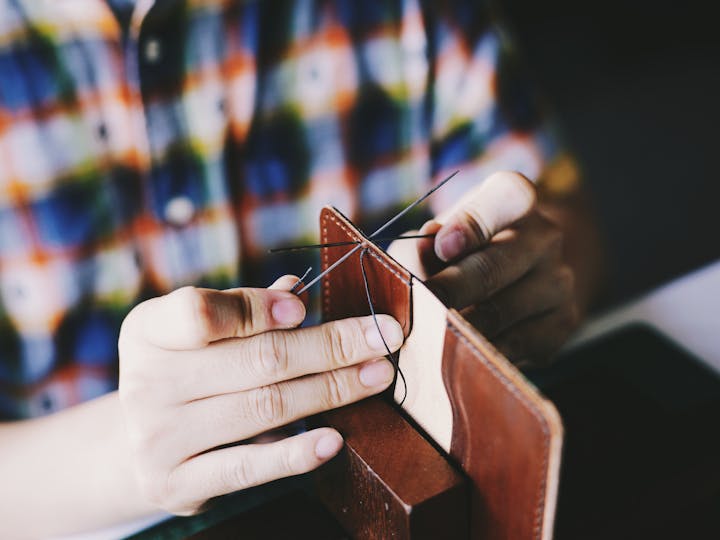When selecting leather for handmade wallets, the type of grain matters more than many realize. Full-grain leather is widely considered the best choice for wallet making, offering top durability, classic aesthetics, and a patina that gets better with age. Many crafters also prefer vegetable tanned leather hides or their ability to be tooled and their long-lasting structure. Understanding the difference between full-grain, top-grain, and other leather types helps buyers make a smart investment in their wallet projects.
Key Takeaways
- Full-grain leather is the top choice for handmade wallets.
- Knowing leather grain types helps ensure a smart purchase.
- Vegetable-tanned leather hides are popular for wallet construction.
Understanding Leather Grain Types for Handmade Wallets
Selecting the right leather grain directly impacts the durability, feel, and appearance of handmade wallets. Each grain type brings distinct qualities that matter for both aesthetics and functionality in leather goods.
Full-Grain Leather Characteristics
Full-grain leather is made from the top layer of the hide, retaining the natural grain and imperfections. This type is recognized for its strength and durability since it includes the strongest fibers. High-quality leather wallets crafted with full-grain leather tend to resist wear and develop a unique patina over time.
It is often chosen by those seeking the best leather for wallets because it is both robust and flexible. The surface is typically left unaltered, preserving the inherent texture and natural marks from the animal. Full-grain leather also absorbs oils from handling, which deepens its color and character. Compared to other types, it requires minimal processing. This makes it a popular choice for premium leather products and luxury leather goods. However, it is usually priced higher due to its quality and longevity.
Top-Grain Leather Attributes
Top-grain leather is produced by sanding away the very top layer of the hide, removing most natural imperfections. This results in a smoother and more uniform appearance, which many consumers prefer for a refined look in leather products. It is slightly less durable than full-grain leather because of the removed fibers. However, it still offers good resistance and is suitable for daily use in leather wallets. Top-grain leather is often treated with finishes or pigments to enhance its appearance and protection against stains.
Top-grain leather balances quality and affordability, making it a common option for high-quality wallets that do not require the highest resilience. It does not develop as pronounced a patina as full-grain, but its smoothness and consistency make it desirable for many handmade projects.
Genuine Leather Overview
Genuine leather is derived from layers beneath the top or full grain and is considered the lowest quality among real leather types used in wallets. It is processed and heavily treated to create a uniform look, which can disguise natural defects but also reduce overall strength and longevity.
Wallets made from genuine leather may appear attractive initially ,but tend to wear out faster, showing creases or cracks with frequent use. The manufacturing process often includes bonding multiple leather scraps together, making it less robust than other leather types. Because genuine leather is more affordable, it is sometimes used for budget-friendly leather goods or practice projects. However, it lacks the aging qualities seen in full-grain and top-grain leather, and usually does not develop a patina or last as long.
Key Factors When Buying Leather Cuts for Wallet Making
Selecting the right leather for a handmade wallet involves careful consideration of thickness, tanning method, and the animal hide used. Each aspect influences durability, workability, feel, and the final appearance of the wallet.
Leather Thickness and Weight Considerations
Wallets require leather that is both sturdy and flexible. Typical leather thickness for wallet-making ranges from 1.0 to 1.6 mm (about 2.5 to 4 oz weight). Thicker leather provides durability, but overly thick pieces can make the wallet bulky and hard to fold.
For card slots and wallet interiors, thinner leather such as 1.0–1.2 mm works best. Main panels and outer shells can use slightly heavier leather for added structure. Using consistent weights across parts helps ensure uniform stitching and finish. When buying leather scraps or full cuts, check for evenness of thickness. Inconsistent thickness causes complications during assembly and may affect the wallet’s longevity and comfort.
Leather Tanning Methods: Vegetable and Chrome
Two primary tanning methods dominate: vegetable tanning and chrome tanning. Vegetable-tanned leather is created using natural tannins from plants. It is firm, ages well, and develops a unique patina. This method is ideal for those who prefer a classic look and want the leather to mold and age over time.
Chrome-tanned leather uses chromium salts, producing a softer, more flexible, and color-consistent hide. Chrome-tanned leather is less affected by moisture and requires minimal break-in time. It is often chosen for vibrant colors and modern aesthetics. When prioritizing environmental factors, vegetable-tanned options are preferable due to fewer chemicals in processing. Wallet makers seeking reliable results for dyeing and tooling frequently select vegetable-tanned cow leather.
Conclusion
Full-grain leather offers the highest durability and natural character, making it the top choice for handmade wallets. Top-grain leather provides a balance of quality and cost, with a smoother surface and good longevity.
Crafters seeking practice material or budget options can consider genuine or bonded leather, but these are less sturdy and age less gracefully. Prioritizing grain type helps ensure the wallet’s lifespan and overall craftsmanship.





